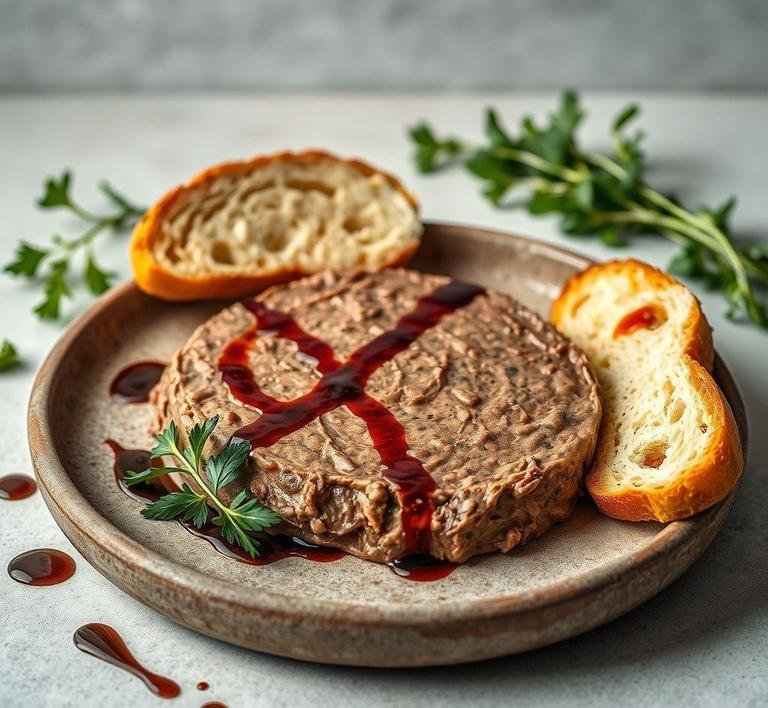Jamie Oliver’s Lamb Liver Pâté is a rich, smooth and savory spread made from lamb’s liver. It has an earthy flavor with a slight sweetness from the addition of ingredients like onions, garlic and herbs. This pâté is a comforting dish that brings together tender, finely processed lamb liver with a variety of seasonings and fats, typically butter, to give it a velvety texture. It’s often served as a starter or spread on crackers, bread or toast, making it a perfect appetizer for a cozy meal or gathering. What sets it apart is the bold flavor of the lamb liver, balanced by the subtle sweetness of sautéed onions and herbs.
Jamie Oliver Lamb Liver Pate Recipe
Ingredients Needed
To create this pâté, you’ll need a selection of simple but flavorful ingredients. Here’s what you’ll typically need:
- Lamb’s liver: The star of the show. You can get fresh or frozen lamb liver from most butcher shops or supermarkets. Make sure to trim any membranes or veins before cooking.
- Butter: A generous amount of butter is essential for that creamy texture and rich flavor.
- Olive oil: Used to sauté the onions and garlic, helping to release all their aromatic goodness.
- Onion: A finely chopped onion is usually sautéed to add a sweet depth of flavor. It helps balance the richness of the liver.
- Garlic: A couple of cloves of garlic, minced or crushed, give an extra layer of savory punch.
- Herbs: Typically thyme and bay leaves are used but you could get creative and experiment with rosemary or sage.
- Cognac or brandy: A splash of brandy or cognac adds a sophisticated richness. It’s optional but really elevates the flavor profile.
- Cream: Heavy cream is added to smooth out the pâté and give it a luxurious finish.
- Salt and pepper: To taste, because no savory dish is complete without the right balance of seasoning.
Equipment Needed
Making Jamie Oliver’s Lamb Liver Pâté doesn’t require any fancy tools but you’ll need some essential kitchen equipment:
- Frying pan or skillet: A good-sized skillet is ideal for sautéing the onions, garlic and liver.
- Sharp knife: For trimming the liver and chopping ingredients like onions and garlic.
- Chopping board: To safely cut and prepare everything.
- Blender or food processor: To purée the mixture into a smooth, spreadable consistency. If you don’t have either, you can mash it manually with a fork, though a blender gives a much better result.
- A bowl: For mixing everything together once it’s blended.
- Small saucepan: If you want to cook the cream and cognac separately before adding them to the pâté.
- Spatula or wooden spoon: For stirring and scraping down the sides of the blender or food processor.
How To Make Jamie Oliver’s Lamb Liver Pâté
Let’s dive into the steps of crafting this smooth, flavor-packed pâté.
- Prep the liver: Start by trimming any membranes and veins from the lamb’s liver. Cut it into small chunks so it cooks more evenly.
- Sauté the onions and garlic: In your frying pan, heat some olive oil over medium heat. Add the onions and cook them until they’re soft and golden brown-this takes about 5-8 minutes. Add the garlic and cook for another minute. The smell at this point is already incredible!
- Cook the liver: Toss the liver chunks into the pan and cook them until they’re browned on the outside but still pink inside. This will only take a few minutes and it’s crucial not to overcook the liver to keep it tender. Add the thyme or bay leaves here for more flavor.
- Add the brandy: Once the liver is browned, pour in a splash of brandy or cognac. Let it bubble up and reduce for a minute. The alcohol will cook off, leaving behind a rich, deep flavor.
- Cream it up: Now, pour in the cream. Stir everything together and let it cook for another 2-3 minutes until it’s nicely combined.
- Blend to perfection: Transfer everything into a blender or food processor. Add a generous amount of butter and blend it until smooth. You can add more butter for extra richness or a bit of cream to adjust the consistency. Taste and adjust seasoning with salt and pepper as needed.
- Chill: Once you’ve got your pâté smooth and creamy, transfer it to a container and refrigerate it for at least 2 hours or even overnight. This helps the flavors meld together and the pâté firm up.
- Serve and enjoy: Serve it chilled with slices of crusty bread, crackers or fresh veggies. A few sprigs of fresh herbs or a drizzle of olive oil on top adds a lovely touch.
What I Learnt

Making Jamie Oliver’s Lamb Liver Pâté was an enlightening experience. First off, I discovered that lamb liver is far less intimidating than I had imagined. The key is not overcooking it and allowing those flavors to meld together slowly. The onions and garlic work wonders at balancing the liver’s natural richness while the butter and cream elevate everything to a dreamy, velvety texture. Using brandy or cognac is a game changer. it adds a lovely depth that really makes the pâté stand out.
I also learned that the chilling process is not to be skipped. The pâté firms up nicely in the fridge and the flavors deepen, creating a much better texture than if you tried to eat it immediately.
One thing I’d also recommend is adjusting the seasonings to your taste. Jamie’s recipe offers a great base but I found myself experimenting with more garlic or a bit more thyme, depending on what I felt like.
Recipe Tweaks For Jamie Oliver’s Lamb Liver Pate
Jamie Oliver’s lamb liver pâté is already a rich, flavorful dish. But, if you’re feeling experimental or just want to tailor it to your preferences, here are some tweaks to make it your own.
-
Herbs and Spices
Adding a variety of herbs can completely change the flavor profile. You could swap the thyme for rosemary or tarragon for an earthier twist. Fresh parsley, a little sage or even a touch of oregano can create a fresh herbal backdrop. For a little heat, a pinch of smoked paprika or ground cumin adds depth and a bit of warmth. If you want to bring out a sharper flavor, a tiny bit of mustard powder or grated horseradish could make a difference.
-
Sweetness with a Twist
You can adjust the balance of sweetness in the pâté. Swap out the traditional use of shallots with caramelized onions or even roasted garlic for a sweeter, more mellow flavor. Alternatively, a tablespoon of brandy or even some balsamic vinegar while cooking can bring an elegant complexity.
-
Adding Creaminess
The pâté already has butter but if you’re looking for an ultra-creamy texture, a splash of double cream (or even mascarpone) when blending can add richness. For a lighter version, swap the cream with Greek yogurt which will give it a tangy bite.
-
Incorporating Different Textures
Want a bit of crunch? Adding toasted nuts like pine nuts, pistachios or even crushed hazelnuts can elevate the texture of the pâté. For a more rustic approach, you could blend part of the liver mixture and leave some of it chunky for a bit more bite.
-
Infusing Flavors
If you want to infuse a smoky taste, consider using smoked butter instead of regular butter or even a dash of liquid smoke. It’s a small addition but makes a big difference. Or try adding a splash of a fortified wine like Madeira or port for a deeper, slightly sweet undertone.
Storage Tips For Leftovers
Liver pâté can be a bit tricky when it comes to storing leftovers but with the right care, you can keep it fresh for several days.
-
Cool Down First
Once you’ve made the pâté, let it cool completely before storing. Hot pâté placed in a container can create condensation which might alter the texture and flavor.
-
Seal It Tight
When storing, the key is to prevent the pâté from being exposed to air. A tightly sealed container is ideal. But, if you want to preserve that silky texture for as long as possible, consider creating a thin layer of melted butter on top of the pâté before sealing it. This acts as a barrier and keeps it fresh longer.
-
Fridge Life
The pâté will last about 3-5 days in the fridge when stored properly. However, if you notice a change in color or smell, it’s best to discard it. The richness of the liver can sometimes develop off flavors after a while.
-
Freezing for Later
Yes, you can freeze liver pâté! Just be mindful of the texture. When freezing, place it in an airtight container or wrap it in plastic wrap and aluminum foil. It can last in the freezer for about 1-2 months. To defrost, let it thaw in the fridge overnight. The texture might change slightly but it will still be delicious.
What To Eat With Jamie Oliver’s Lamb Liver Pate?
The beauty of pâté lies in its versatility. Here are a few great pairing ideas:
-
Crusty Bread
A fresh baguette or a hearty sourdough makes the perfect base for lamb liver pâté. The crust gives a satisfying crunch while the interior softness complements the creamy pâté.
-
Pickles and Chutneys
The tang of pickles (such as cornichons) or a sweet chutney (fig or onion) provides a perfect contrast to the rich and savory pâté. The acidity and sweetness balance out the richness and make each bite more enjoyable.
-
Cheese
A soft cheese like brie or a tangy blue can complement the flavors in the pâté. Spread a little pâté on crackers, top with a slice of cheese and you’ve got a wonderful flavor combination.
-
Crisp Vegetables
Lightly pickled or raw vegetables, like cucumber or carrot sticks, add a refreshing crunch and a slightly bitter contrast to the fatty richness of the pâté.
-
Wine Pairings
For wine lovers, a glass of red wine like a Shiraz or a Bordeaux blends beautifully with the pâté. The deep, tannic qualities of these wines cut through the richness, balancing the dish perfectly.
-
Salads
A simple green salad with a zesty vinaigrette helps cut through the richness and adds a fresh, crisp texture that balances the deep flavors of the pâté.
FAQs
What Ingredients Do I Need For Jamie Oliver’s Lamb Liver Pâté?
You’ll need lamb liver, butter, onions, garlic, thyme, brandy or sherry, and seasoning like salt and pepper.
How Long Does Jamie Oliver’s Lamb Liver Pâté Last In The Fridge?
It lasts up to 3-4 days when stored in an airtight container in the fridge.
Can I Make Jamie Oliver’s Lamb Liver Pâté Ahead Of Time?
Yes! It’s perfect to make a day or two in advance, as the flavors will develop and deepen.


